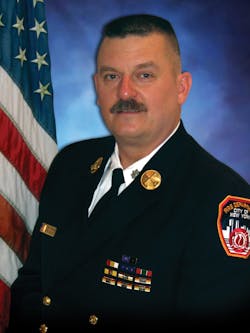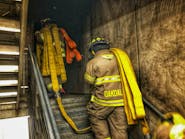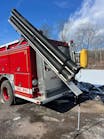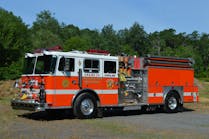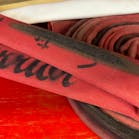The Fire Scene: The Dead Load
There are many different types of hose loads that are used for a multitude of reasons. Many engine companies use several pre-connected attack hoselines. As a matter of fact, I believe you could safely say that almost all departments use the pre-connected line as a primary attack hoseline. The pre-connected hoseline is exactly what it sounds like: It is several lengths of hose packed into a hosebed, it is connected to a discharge at the bottom of the bed, and it has a nozzle attached at the top of the packed hose. This makes for a very rapid hose stretch, and eliminates the need for firefighters to specifically decide how many lengths they want to stretch and, more importantly, it eliminates the need to break the line at a coupling and connect the male end to a discharge on the apparatus.
The dead load is quite different from the pre-connect. The dead load usually consists of a larger hosebed that simply has a greater number of lengths packed into it. Additionally, the hose is not pre-connected to the apparatus. It is simply a pile of hose, packed into the compartment and available for the stretch. The term “available” simply means that you may or may not use all of the hose.
For example, you pull up to a motel and you have visible fire on the third floor, several hundred feet away from the nearest approach for the apparatus. You estimate that you may need 300–350 feet of hose to reach the fire. Your three pre-connected lines are 200, 250 and 300 feet long. What now? Well instead of getting into a situation where you have to start adding lengths to a short line, you simply order the dead load pulled. Your dead load has 10 lengths of 2½-inch hose with a reducer and 6 lengths of 1¾-inch hose attached with a nozzle on top. That line is pulled—and pulled and pulled—until the crew has removed enough hose for the job at hand, and then it can be broken or disconnected at the next coupling and connected to a discharge on the pumper.
The water supply end of this is interesting, too. If your company lays a supply line expecting to use their pre-connected attack line, that’s fine. They now have a supply line in and an attack line out. If the engine arrived and stopped at a hydrant, again expecting to use the pre-connect, but they pulled the dead load instead, they are still ready to go with water in from the hydrant and out via the attack line. But what if they arrived and no hydrant was available and a supply line had not been dropped on the way in? That’s a problem with a pre-connect because you would have to call for another unit to establish a water supply for you. This is not a problem if you had stretched from a dead load bed. In that case, the nozzle team would still pull the required number of lengths out of the bed, for example 6 or 7, and the driver/engineer could simply drive the apparatus down the street to the next hydrant, laying several more lengths of hose, let’s say 2 or 3 from that same bed. Even though the nozzle team only handled 6 or 7 lengths, the total stretch ends up at 10 lengths. This wouldn’t be possible with a pre-connected line.
Let’s look at another example: An engine company arrives at a five-story apartment building with visible fire on the 5th floor. All of the three pre-connected attack lines are the same length, 250 feet. Can we guarantee that one of these will reach the apartment and make it through to the last room? I don’t think so. Instead, the firefighters pull the line from the dead load and immediately begin their stretch. No fumbling or bumbling with adding lengths when there is a fire to be extinguished.
Another point concerning dead load hose: Obviously, you can have 10 to 15 lengths of 2½-inch hose with a nozzle on top. But when you want to stretch a 1¾-inch line, you can’t use 15 lengths of that hose because the friction loss in the smaller diameter line will create pressure problems. That’s why we use 10 lengths of 2½-inch with 6 lengths of 1¾-inch on top.
If this sounds like it might make a nice addition to your engines hoseline options, try it! You might like it.

John J. Salka Jr. | Battalion Chief
JOHN J. SALKA JR., who is a Firehouse contributing editor, retired as a battalion chief with FDNY, serving as commander of the 18th battalion in the Bronx. Salka has instructed at several FDNY training programs, including the department’s Probationary Firefighters School, Captains Management Program and Battalion Chiefs Command Course. He conducts training programs at national and local conferences and has been recognized for his firefighter survival course, “Get Out Alive.” Salka co-authored the FDNY Engine Company Operations manual and wrote the book "First In, Last Out–Leadership Lessons From the New York Fire Department." He also operates Fire Command Training, which is a New York-based fire service training and consulting firm.
